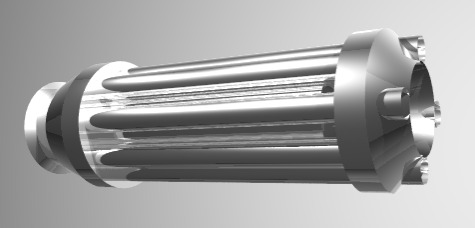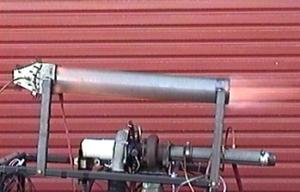| The |  | TM |
Last Updated: 3 February, 2003

February 2003 Updates An announcement regarding the first commercial applications of the X-Jet will be made in the first quarter of this year. Details of the X-Jet project will shortly be moved to a new website currently under development at X-Jet.com. Development News (21 May 2002) Project Objectives And Status Report (15 May 2002)
Earlier Prototypes You'll need to download the whole 1.7MB file and view it with a RealPlayer.

Click to view the video Unfortunately the sound level generated by the engine during the test is so high that it completely overloaded the microphone built into my video-recorder so I'm going to have to use an external mic in a sound attenuating enclosure for future videos. During this video, the engine is throttled through a range of power settings from around 20lbs thrust up to over 65 lbs (35% to 120% of the normal operating range). Although you can't hear much difference in the engine sound because of the overloading problems you will note a difference in the engine temperature and nature of the exhaust gasses. The next phase in the engine development is the addition of a full-length augmentor shroud which will not only significantly reduce the operating temperature of the engine's external elements (to under 200 deg C) but also increase thrust by an additional 30%-40%. Experienced pulsejet engine builders will notice that this engine is running with what appears to be a very short tailpipe -- it has a length/diameter ratio of just over 6:1, far shorter than that required by traditional engines. This engine (of nominally 55 lbs thrust) has a tailpipe of just 60cm (24 inches) in length The result is an engine which operates at a very high frequency for the amount of power it produces. This higher frequency means that the amplitude of vibrations generated by the combustion pulses is markedly lower than normally encountered in a pulsejet. As of June 4, the second prototype has accumulated almost 10 hours of running time and is still using the original reed valves which, although slightly discolored by heat transferred from the combustion chamber, show no signs of the fraying or deformation that typically result in failure with traditional pulsejet engines. I anticipate that the serviceable life of the reed valves in this engine will be in excess of 30 hours -- almost 100 times longer than that possible with other designs.
The World's Most Efficient Pulsejet? Called the X-Jet, the new engine offers the following:
I've dubbed the mechanism whereby this increased compression ratio is achieved to be a type of "gas flywheel" effect. Although combustion is still a deflagration process, the combustion pressure (and therefore the thrust) achieved is significantly higher than with a regular puslsejet engine. Development work is continuing on this new engine, with early results so promising that it is now partially funded by a $30,000 technology grant made available by the New Zealand government. It is anticipated that further research and development will yield even greater performance and fuel-efficiency as work continues on this new design. Already these new breakthrough developments have significantly increased the viability of the pulsejet as a method of propulsion for recreational and military aviation. The previous limiting factors of reliability and the need for a heavy fuel-load have been largely addressed, thus allowing the X-Jet's use as a source of power for microlight or small homebuilt aircraft, karts, bikes, models, and a range of other vehicles. It is also ideally suited to use in "disposable" military vehicles such as remotely piloted reconnaissance aircraft, high-speed target drones, and even low-cost self-guided missiles.
|
|
